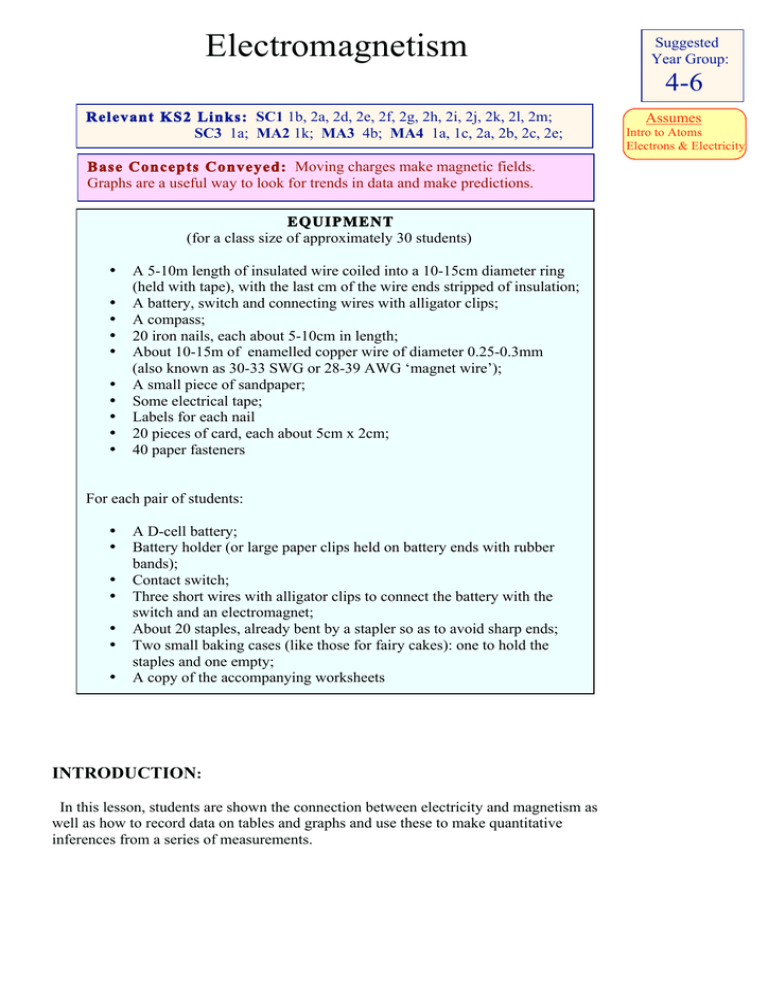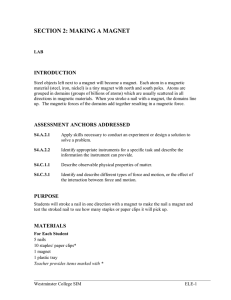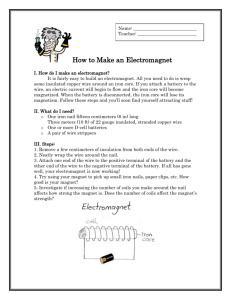advertisement

Electromagnetism Suggested Year Group: 4-6 Relevant KS2 Links: SC1 1b, 2a, 2d, 2e, 2f, 2g, 2h, 2i, 2j, 2k, 2l, 2m; SC3 1a; MA2 1k; MA3 4b; MA4 1a, 1c, 2a, 2b, 2c, 2e; Base Concepts Conveyed: Moving charges make magnetic fields. Graphs are a useful way to look for trends in data and make predictions. EQUIPMENT (for a class size of approximately 30 students) • • • • • • • • • • A 5-10m length of insulated wire coiled into a 10-15cm diameter ring (held with tape), with the last cm of the wire ends stripped of insulation; A battery, switch and connecting wires with alligator clips; A compass; 20 iron nails, each about 5-10cm in length; About 10-15m of enamelled copper wire of diameter 0.25-0.3mm (also known as 30-33 SWG or 28-39 AWG ‘magnet wire’); A small piece of sandpaper; Some electrical tape; Labels for each nail 20 pieces of card, each about 5cm x 2cm; 40 paper fasteners For each pair of students: • • • • • • • A D-cell battery; Battery holder (or large paper clips held on battery ends with rubber bands); Contact switch; Three short wires with alligator clips to connect the battery with the switch and an electromagnet; About 20 staples, already bent by a stapler so as to avoid sharp ends; Two small baking cases (like those for fairy cakes): one to hold the staples and one empty; A copy of the accompanying worksheets INTRODUCTION: In this lesson, students are shown the connection between electricity and magnetism as well as how to record data on tables and graphs and use these to make quantitative inferences from a series of measurements. Assumes Intro to Atoms Electrons & Electricity PREPARATION For each table of 8 students, divided into 4 pairs of working partners, you will need to prepare 5 wound nails using the wire. In each case, leave about 20cm of wire at the ends, as illustrated below. The number of windings on each of the first 4 nails should be as follows: 10 loops, 20 loops, 30 loops and 40 loops, respectively. The 5th nail should be wound with a different number of loops for each table: 15, 25, 35 and 50, for example. The wire can be easily cut to length with a pair of scissors. Using the sandpaper, pinch and pull along the last couple centimetres from each end to rub off the enamel insulation and then twist these into loops. Use electrical tape to wrap around each of the nails to secure the coil and affix a tag that indicates how many loops are in each coil except for the 5th nail, where the number of coils will be kept secret. Instead, label this with a different letter for each table (but record for yourself how many loops correspond to each letter!). Use paper fasteners to secure the end loops from each nail to pieces of card. This will be used for fastening alligator clips. TEACHING: Review the idea of electric circuits and batteries in terms of the flow if electrons through wires. Speculate on whether it might be possible to “see” the movement of electrons without using a light bulb or something similar. Bring out the large coil of wire and hook it up to the battery and switch. Note that it is coiled up so we can look at the effects in a long length of wire without having to stretch it out across the whole room. Ask for a volunteer and give them a compass, instructing them to move the compass around near the coil of wire while you open and close the switch and to describe what they see. The compass needle will deflect when it’s near the coil whenever the switch is closed and will swing back when it is opened. Notice that the compass needle deflects in opposite directions when it is on different sides of the coil. What does this behaviour tell you? Do you remember what a compass needle is made from? Right, the compass needle is a magnet and when it moves it tells you there must be a magnetic field somewhere which is pushing on it (i.e. exerting a force). But where did the magnetic field come from? Is the wire itself magnetic? With the switch open (i.e. no current flowing through the circuit), have them move the compass around different parts of the wire. No deflection. Are the electrons magnetic? Have them move the compass around different parts of the battery, since that’s where the excess electrons that run through the circuit are stored. No deflection. Yet a magnetic field appears when the switch is closed… so, what is different in that case? When the switch is closed, the electrons move through the wire, and since neither the wire nor the electrons are themselves magnetic, it must have to do with movement. Indeed, this is the case: moving charges make magnetic fields. But what about permanent magnets, the kind made of metal that you can carry around? Are there any moving charges in those? Ask the students what these magnets are made of… what all normal materials are made of. Right, atoms! And what do atoms look like? Ask a volunteer to draw a picture on the board. They have a positively charged centre (called the nucleus) and negatively charged electrons that race around it. Ah! So there are moving charges! The electrons go around atoms a bit like the electrons going around the loops of the coiled wire. So, each atoms acts like a very, very, very tiny magnet. In most materials, they point in lots of different directions, so their effects cancel out (for every one exerting a pushing force, another one is twisted a different way and exerts a pulling force to cancel it). However, what if you could take millions and millions of these atoms and point them in the same direction? Their tiny magnets would all add together to make one big magnet! Certain materials are easier to line up atoms in this way and make them stay in that direction, so these are the ones we can make into permanent magnets. What about cases where the atoms don’t stay pointing in the same direction? Then the material will act like a magnet temporarily, as long as there is something that keeps the atoms in line. This is the principle of an electromagnet, where coils are used to make a magnetic field that aligns some of the atoms in a metal, which then act together to make an even stronger magnet. But when the coil is switched off, the atoms more or less turn back to their original directions and the piece of metal stops acting as one big magnet. How does a compass behave near a circuit? Where do magnetic fields come from? How do permanent magnets work? What is an electromagnet? ACTIVITY: Divide the class into pairs of working partners. Have each pair take one of the wound nails labelled with numbers, explaining that the numbers refer to the number of times the wire is wrapped around the nail. When this is hooked up to a circuit, the electrons moving around the coil will make a magnetic field that then aligns some of the atoms in the nail to make an even stronger magnet. Following the worksheet, each pair should hook up their wound nails in a circuit to make an electromagnet and see how many staples they can pick up with the head of the nail when the switch is closed. They should write this number down along with the number of coils on their magnet and then also record this by drawing a small circle on the appropriate part of the accompanying graph. When everyone has done this, they should disconnect their magnet and swap by passing it to the pair of students on their right. They should then repeat the whole procedure until each pair has made 4 measurements with the different numbers of windings and plotted them on the graph. Do they notice any trends in their plots? They should show an approximately linear trend, with the number of staples lifted roughly proportional to the number of windings. This is because more windings produce an appropriately larger external magnetic field that better aligns the atoms in the metal nail. What else might do this? Right, a greater flow of electrons (that is, a larger electric current) would also increase the strength of the electromagnet. The students have now calibrated the strength of their electromagnets as a function of the number of windings. We can now make use of this: Next give each table a “mystery nail,” labelled with a letter, where the number of windings are unknown to the students. Have the groups at each table measure how many staples can be picked up when it is put into a circuit and ask everyone at each table to write down their numbers. From that measurement, can you think of a way to estimate how many turns of wire are on the nail? Right – each pair should look at their graph and try to guess where they might draw a point for that number of staples that fits in with the pattern they’ve determined from known windings. In fact, each pair should place a cross on their graph where they think the mystery nail would fit. Have those at each table compare their results and agree on the overall best guess for what the number of windings is. Write each of these on the board at the front of the class, along with the corresponding letter associated with each nail. Finally, reveal what the true answer is for each letter… how close did everyone get? Watch web video on CERN (use of electromagnets to study interesting aspects of what the universe is made from): http://www.pbs.org/wgbh/nova/sciencenow/3410/02.html Quick Reference o o o o o o o o Review circuits in terms of flow of electrons. Can we sense electrons are moving? Show compass needle is deflected – what does this say? Where did magnetic field come from? Check wire alone and battery. Moving charges produce magnetic fields! How do permanent magnets work? Moving electrons in atoms. Align atom directions to make tiny magnet fields add together. Electromagnet: temporary alignment using an external field from a coil. o After worksheet, discuss trends and how they relate to alignment of atoms (more windings & larger current would produce a larger external magnetic field to better align the atoms). o Mention the term “calibration” of the magnet strength in context of their graphs. o Have groups work out mystery nail windings, marking crosses on their graphs and comparing results with others at their table. o Reveal answers to class and see how close everyone got. o Watch web video about CERN. Electromagnetism Using the battery, switch and alligator clips provided, hook up a circuit so that, when the switch is closed, electrons flow through the wire wrapped around your nail to make an electromagnet. Draw a picture of this circuit in the box below and use arrows to show which way the electrons are flowing. How many times is the wire wrapped around your nail? (it should say on the label) When the switch is turned on, you should be able to pick up staples from one cup and then drop them in the other cup by turning the switch off again! How many staples can you pick up at once with the head of the nail (the flat end) when the switch is turned on? Record what you’ve found in the first row of the table on page 2 by writing down the number of coils on your nail and the number of staples lifted on the first line of the table. Page 1 Data Table Number of coils around your nail Number of staples lifted When everyone at your table has done this, disconnect your electromagnet and pass it to the pair of working partners on your right. Then take the new electromagnet you are given, hook it up to your circuit, and see how many staples you can pick up now. Record this, along with the number of coils around this nail, on the second line of the table on this page. Do all of this 2 more times, until you have measured 4 different electromagnets and have recorded what you’ve found on each of the 4 lines in the table. Page 2 Look at the data table and record each measurement again on the graph below by doing this: 1) find the number of coils at the bottom of the graph 2) find the number of staples lifted on the side 3) draw a small circle where the two lines come together. You should end up with 4 circles for the 4 electromagnets. Do you notice any pattern? Is it what you expected? Why? Page 3 Page 3




